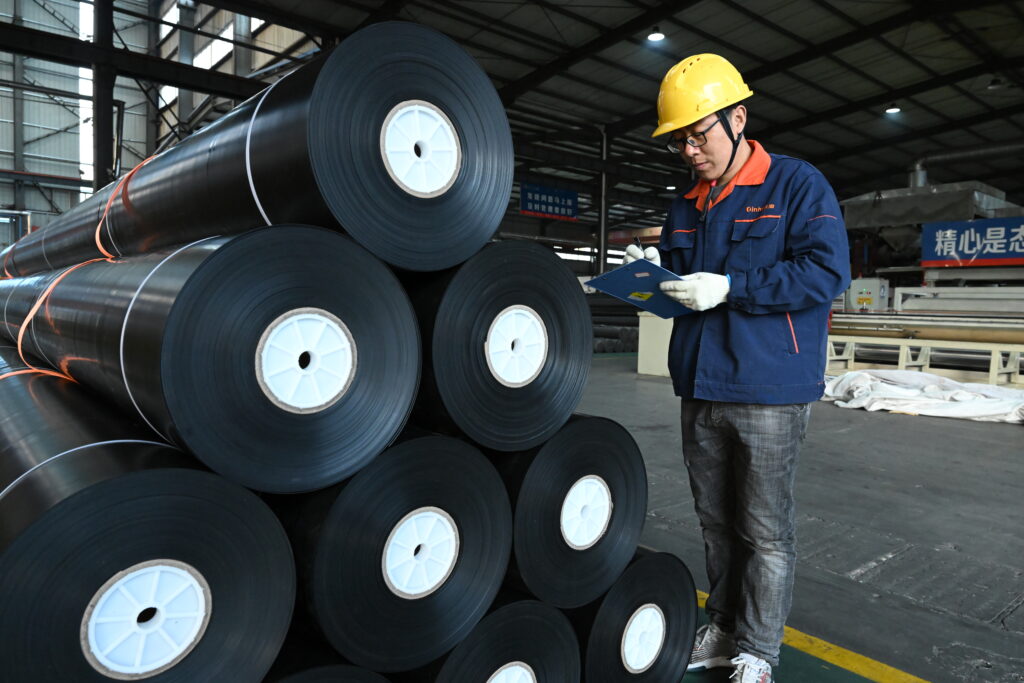Why is geomembrane important?
Geomembrane plays an important role in civil engineering and environmental engineering, and its importance is reflected in many aspects:
Anti-seepage effect: Geomembrane has anti-seepage properties and can effectively prevent water, chemicals, etc. from penetrating into the soil. This is critical in water conservancy projects, landfills, ponds and dams, to prevent groundwater contamination or to protect the stability of structures.
Isolation and Stratification: Geomembranes can be used to isolate different soil layers and prevent them from mixing with each other. This is essential to maintain the mechanical properties of the soil and prevent interpenetration of particles from different soil layers, especially in weak foundation conditions.
Reinforcement of soil: Some geomembranes are designed to have high tensile strength and stiffness and can be used to reinforce soil. This is crucial when the soil is weak, unstable or needs to be strengthened, such as in road construction, dam reinforcement, etc.
Prevent soil erosion: Geomembranes can be used to prevent soil erosion from water flow. This plays an active role in soil protection on river banks, river channels, slopes and other places.
Environmental Protection: Geomembranes can help protect the environment from pollution by preventing chemicals, hazardous materials, or waste from leaching into soil and groundwater.
Extend project life: By preventing the penetration of moisture, chemicals, and other external factors, geomembranes help extend the life and sustainability of structures and installations.
Improve project efficiency: In some special projects, geomembrane can be used to improve the efficiency of project construction, reduce the amount of earthworks, and reduce construction costs.
Generally speaking, the use of geomembranes in civil engineering and environmental engineering plays an important role in protecting the environment, maintaining the stability of engineering structures, and extending the life of projects. The correct selection and use of geomembranes is an important part of ensuring the sustainability and safety of the project.
What are the three types of geomembranes?
There are many different types of geomembranes, which can be divided into the following three main types based on their composition and function:
LDPE (Low Density Polyethylene) Geomembrane: LDPE geomembrane is a film made of low density polyethylene. It is often used in anti-seepage applications to prevent moisture, chemicals and other liquids from penetrating into the soil. This type of geomembrane is commonly used in projects such as landfills, wastewater treatment facilities, dams, ponds, and more.
HDPE (High Density Polyethylene) Geomembrane: HDPE geomembrane is made of high-density polyethylene and is relatively strong and durable. It is commonly used in anti-seepage, isolation and reinforcement applications. HDPE geomembrane has a wide range of uses in road construction, river bank reinforcement, soil isolation in stacking areas, etc.
PP (polypropylene) geomembrane: PP geomembrane is made of polypropylene and is commonly used for separation, filtration and reinforcement. It is widely used in fields such as soil isolation, hydraulic engineering, soil stability improvement and river protection. PP geomembranes generally have high tensile strength and chemical resistance.
The choice between these geomembrane types often depends on specific project needs, soil conditions and environmental factors. Each type of geomembrane has its specific advantages and areas of application, so the characteristics of the project need to be comprehensively considered when selecting a geomembrane to ensure the best results.

What is a geomembrane used in mining?
Geomembrane for mining is a special type of geomembrane, often called “mining geomembrane” or “mining anti-seepage membrane”, which is specially used in mining projects. This geomembrane plays a variety of key roles in the mining industry, including the following:
Anti-seepage: Mining projects often require the treatment of large volumes of water, including drainage, process water and wastewater. Mine geomembranes are used to prevent this water from seeping into surrounding soil or groundwater to reduce environmental impact.
Soil Isolation: In mining activities, large amounts of waste, muck and hazardous materials often need to be handled. Geomembranes are used to isolate these wastes and prevent them from having a negative impact on the surrounding environment.
Environmental Protection: Mining activities may cause environmental problems such as soil contamination and water contamination. Mine geomembranes help mitigate these impacts and protect surrounding ecosystems.
Maintaining the stability of engineering structures: Geomembranes are used to strengthen soil in structures such as mining dams, ore stockpiles, and stacking areas to improve the stability and safety of projects.
Reduced amount of earthwork: By using geomembranes, the amount of earthwork that needs to be excavated or filled can be reduced, thereby reducing project costs.
Geomembranes used in mining often require specific physical and chemical properties to address the challenges found in mining environments. This includes requirements for tensile strength, chemical resistance, UV resistance and mechanical strength. In addition, the selection of geomembrane should also be based on the specific needs and regulatory standards of the mining project to ensure environmental and project sustainability.

